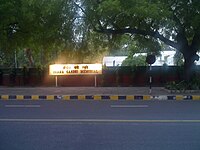
Back ইন্দিরা গান্ধীর গুপ্তহত্যা Bengali/Bangla Assassinat d'Indira Gandhi Catalan Asesinato de Indira Gandhi Spanish ترور ایندیرا گاندی Persian Indira Gandhin murha Finnish Assassinat d'Indira Gandhi French इंदिरा गांधी की हत्या Hindi Ինդիրա Գանդիի սպանությունը Armenian Pembunuhan Indira Gandhi ID ഇന്ദിരാഗാന്ധി വധം Malayalam
| Assassination of Indira Gandhi | |
|---|---|
 The spot where Gandhi was shot down is marked by a glass opening in the crystal pathway at the Indira Gandhi Memorial | |
| Location | Prime Minister residence, Safdarjung Road, New Delhi |
| Date | 31 October 1984 9:30 a.m. |
Attack type | Assassination |
| Weapons | .38 (9.1 mm) revolver and Sterling submachine gun |
| Victim | Indira Gandhi |
| Assailants | Satwant Singh and Beant Singh |

| ||
|---|---|---|
|
1966–1977 1980–1984
Legislation
Treaties and accords
Missions and projects
Controversies
Riots and attacks
Constitutional amendments
Gallery: Picture, Sound, Video |
||
Indian Prime Minister Indira Gandhi was assassinated at 9:30 a.m. on 31 October 1984 at her residence in Safdarjung Road, New Delhi. She was killed by her Sikh bodyguards,[1] Satwant Singh and Beant Singh, in the aftermath of Operation Blue Star by Indian Army between 1 and 8 June 1984 on the orders of Gandhi. The military operation was to remove Sikh militant Jarnail Singh Bhindranwale and other Sikh separatists from the Golden Temple of Harmandir Sahib in Amritsar, Punjab, the holiest site of Sikhism. The military action resulted in the death of many pilgrims as well as damage to the Akal Takht and the destruction of the Sikh Reference Library.[2]
Gandhi's assassination by her Sikh bodyguards led to the 1984 Sikh massacres which were instigated by political figures from the Indian National Congress, who orchestrated pogroms against Sikh populations throughout India. Four days of mob violence resulted in the destruction of 40 historic Gurdwaras and other important Sikh holy sites. Official Indian government figures put the death toll at 3,350 while other sources have quoted between 8,000[3] to 16,000[4] Sikhs were killed.
- ^ "1984: Assassination and revenge". BBC News. 31 October 1984. Archived from the original on 15 February 2009. Retrieved 23 January 2009.
- ^ Kiss, Peter A. (2014). Winning Wars amongst the People: Case Studies in Asymmetric Conflict (Illustrated ed.). Potomac Books. p. 100. ISBN 9781612347004. Archived from the original on 15 July 2018. Retrieved 15 July 2018.
In operation Bluestar a force of several battalions occupied the holy precincts in a battle lasting several hours. Bhindranwale and man of his associates were killed – but there was a very large number of civilian casualties as well.
- ^ Ali Riaz; Fahmida Zaman; Zobaida Nasreen, eds. (2018). Political Violence in South Asia. Taylor & Francis. ISBN 9781351118200.
- ^ Brass, Paul R. (2008). The Politics of India Since Independence (2 ed.). Cambridge University Press. p. 200. ISBN 9780521459709.
© MMXXIII Rich X Search. We shall prevail. All rights reserved. Rich X Search

